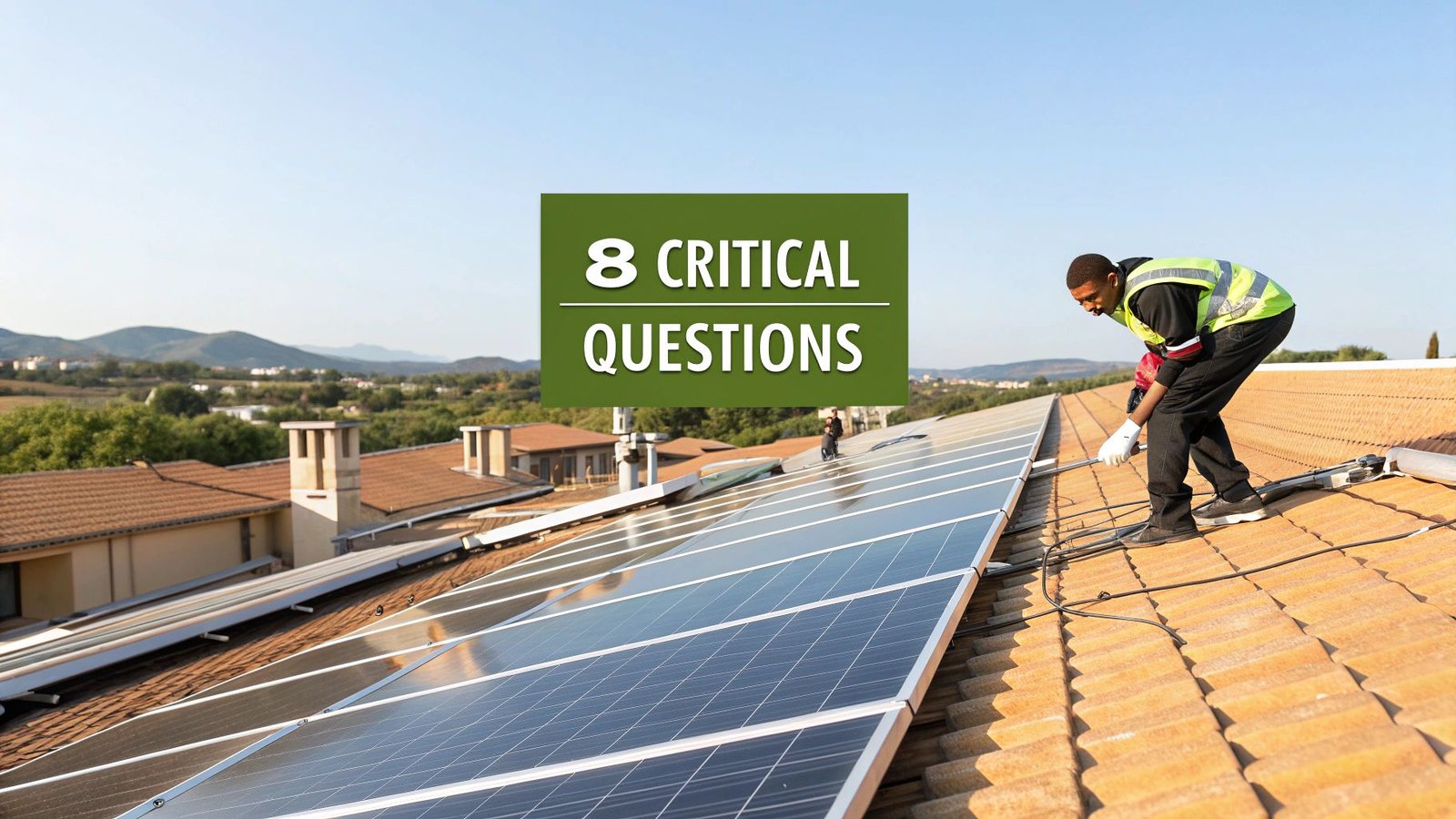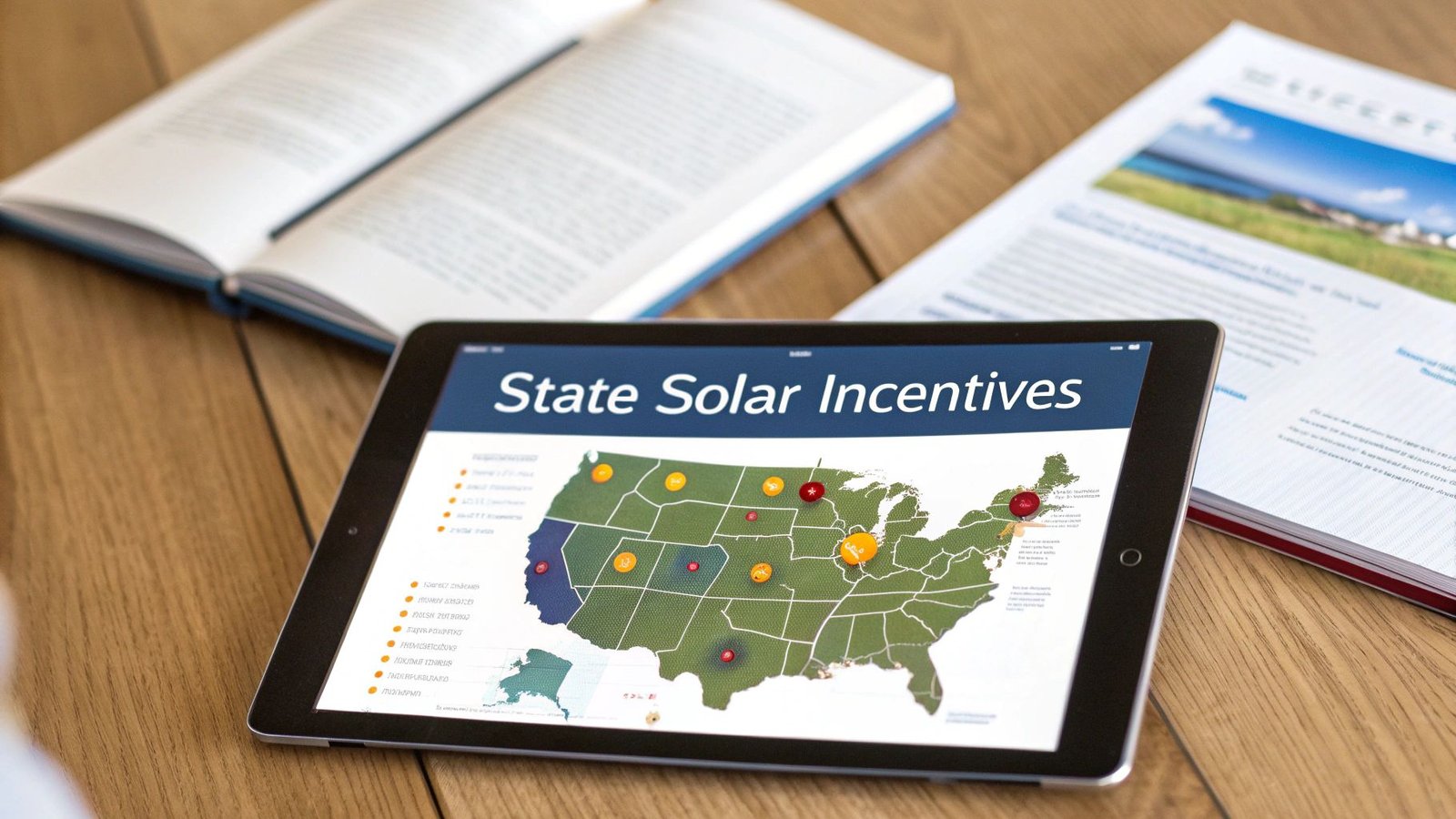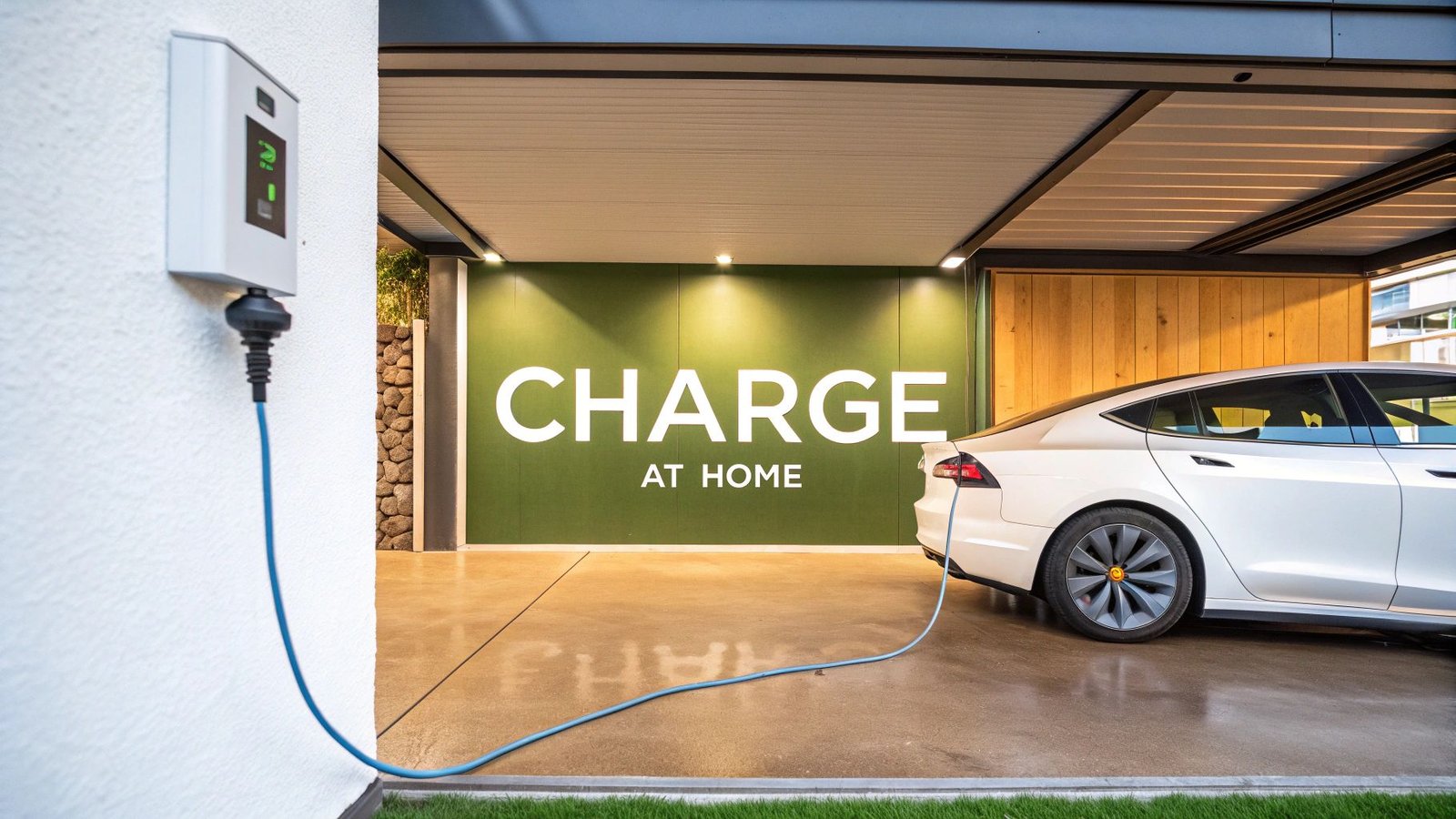So, you're thinking about solar panels and the big question on your mind is, "How much money can I actually save?" It's a great question, and the answer is often surprising.
For the average American homeowner, we're not talking about a few bucks here and there. We're talking about saving tens of thousands of dollars over the life of the system. In fact, typical savings can fall anywhere between $34,000 and $120,000. The final number really comes down to a few key things: where you live, what your local utility charges for power, and the size of the solar array you put on your roof.
Your Potential Solar Savings at a Glance
Think of your potential savings like a recipe. The three main ingredients are the amount of sunshine your home gets, the price you pay for electricity, and the size of your system. When these mix together just right, the financial return can be pretty impressive.
This infographic gives a great visual breakdown of how these core elements come together to determine your total solar savings.
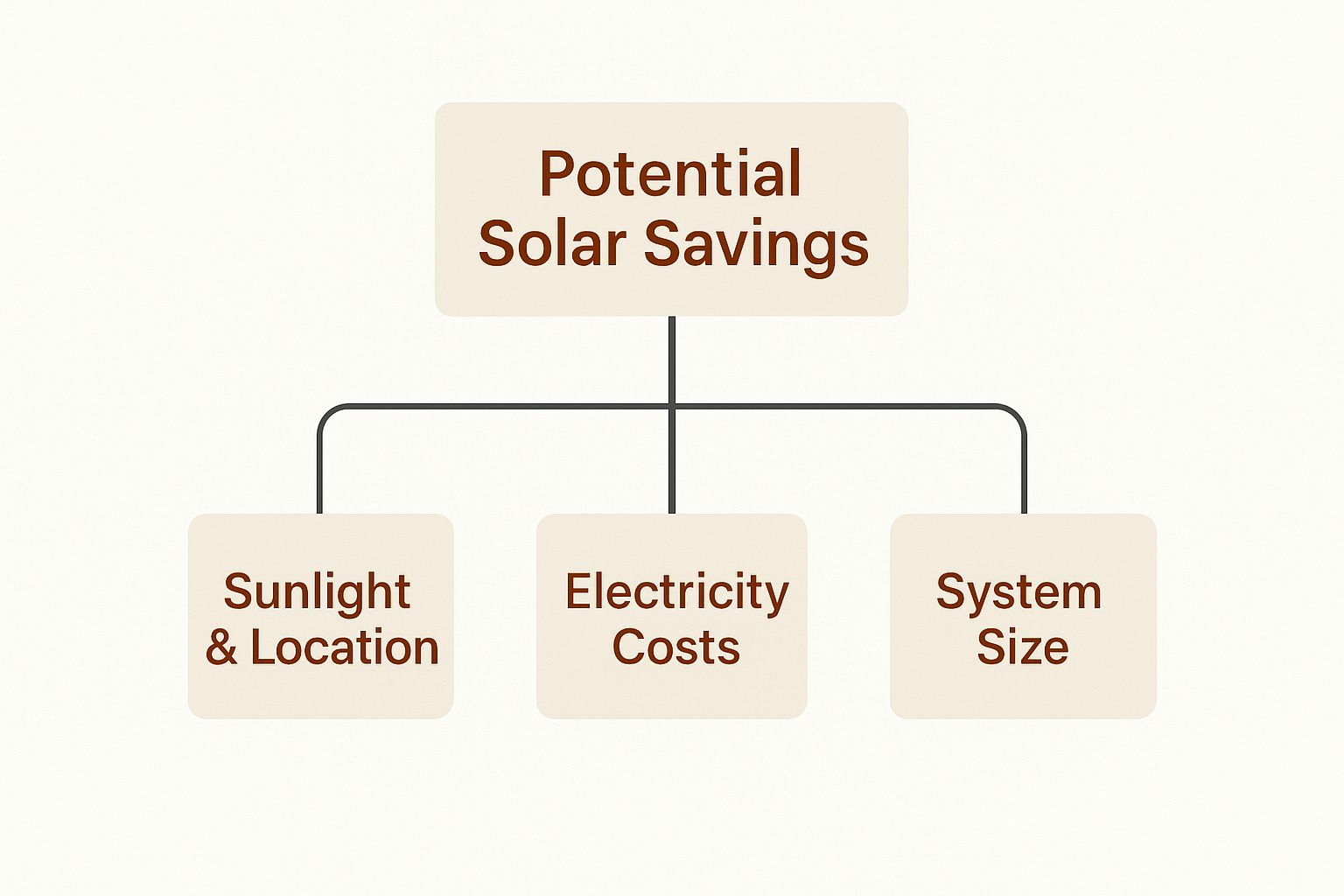
As you can see, these factors are all connected. If you're lucky enough to live in a sunny state where electricity bills are high, your savings are going to stack up much faster than they would elsewhere.
Understanding the Savings Equation
The concept behind solar savings is pretty straightforward. The more you currently spend on your electric bill and the more sun your roof gets, the more valuable each and every solar panel becomes.
A bigger system will obviously generate more power and lead to bigger savings, but it also means a higher upfront investment. It’s all about finding that sweet spot for your specific home and budget.
Think of your solar panels as more than just a way to cut your monthly expenses. They are a long-term asset that will generate real value for decades. By producing your own clean energy, you're essentially locking in your electricity costs and shielding yourself from the unpredictable rate hikes that utility companies are known for.
Across the United States, the average homeowner can expect to save around $52,000 over the 25- to 30-year lifespan of their solar panels. That figure can easily climb much higher in states with great solar incentives and expensive energy.
Estimated Lifetime Solar Savings by U.S. Region
To give you a clearer picture, let's look at how savings can vary across the country. This chart offers a quick overview of potential savings from a typical residential solar system, showing how local electricity rates and sun exposure impact your bottom line.
graph TD
subgraph Northeast
A["~22.8¢ / kWh"] --> B["$60,000 - $120,000"]
end
subgraph Southwest
C["~14.5¢ / kWh"] --> D["$45,000 - $90,000"]
end
subgraph Midwest
E["~15.0¢ / kWh"] --> F["$35,000 - $65,000"]
end
subgraph West
G["~24.5¢ / kWh"] --> H["$55,000 - $110,000"]
end
subgraph Southeast
I["~13.7¢ / kWh"] --> J["$34,000 - $60,000"]
end
Note: These are estimates based on regional averages for a 6kW system. Your actual savings will vary based on your specific location, energy usage, and available incentives.
As the data shows, regions with higher electricity costs, like the Northeast and West, often see the highest lifetime savings, even if they don't get the most sun year-round.
Of course, the best way to get a precise number is to run the figures for your own home. You can get a much better idea of your potential returns by using a solar energy calculator for your home. We'll dive deeper into all these factors to help you see exactly how they influence your bottom line.
The 4 Big Factors That Drive Your Solar Savings
Figuring out how much you'll actually save with solar isn't a simple, one-size-fits-all calculation. It’s more like a recipe with four main ingredients. Each one plays a huge part in determining whether your solar investment is a good deal or a great one.
Let's pull back the curtain on these four factors so you can see exactly how they work together to shape your savings.
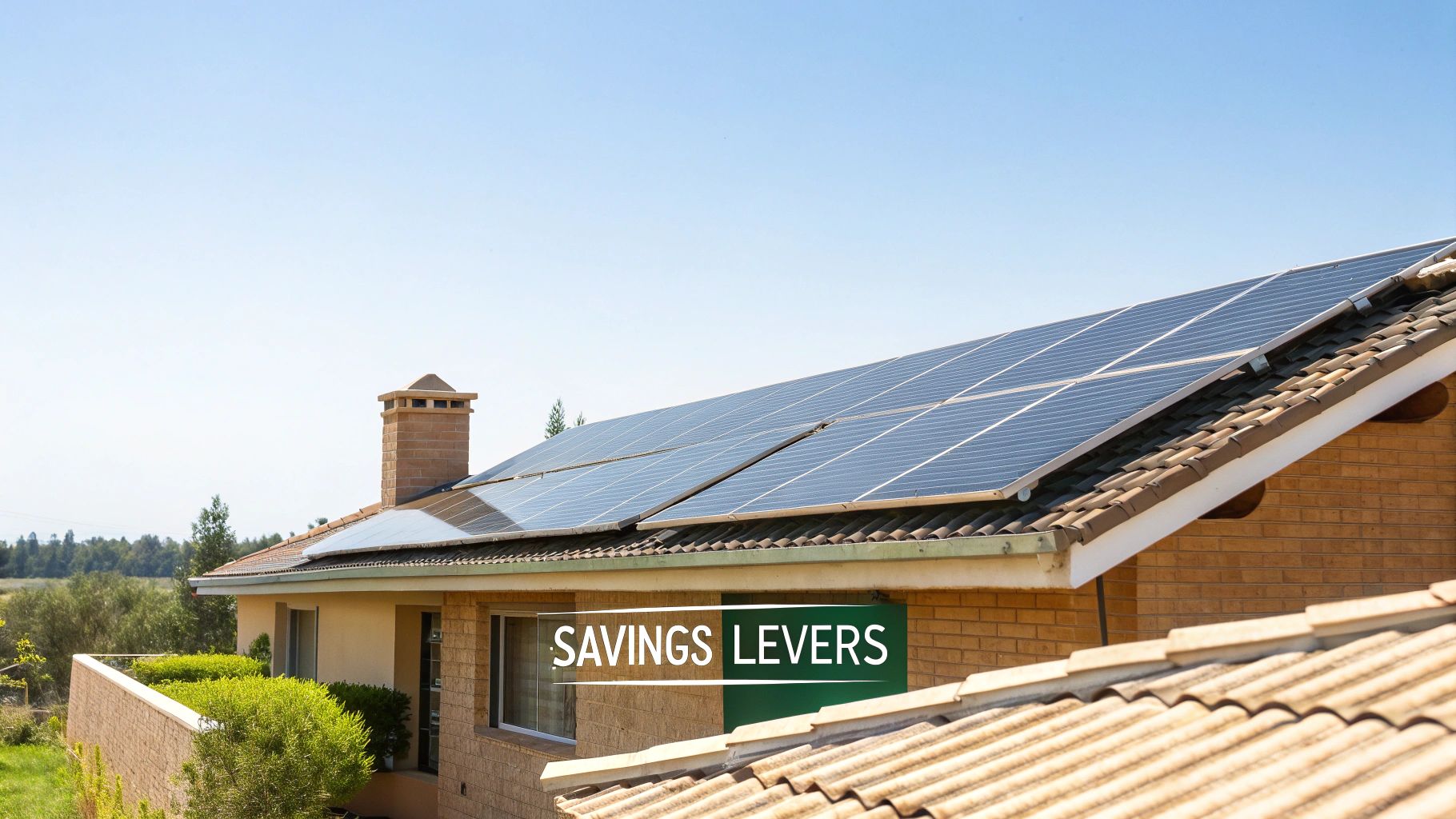
From the sunshine hitting your roof to the fine print on government forms, every detail matters.
Sunlight and Location: Your Roof’s Solar Potential
The first factor is completely out of your hands: geography. Just like with real estate, it’s all about location, location, location. A home soaking up the Arizona sun is going to generate a lot more electricity than one in the often-overcast Pacific Northwest.
But that doesn't mean solar only works in deserts. The real key is the amount of direct, unobstructed sunlight your roof gets. A clear, south-facing roof is the gold standard, but modern panels are surprisingly efficient even in less-than-perfect conditions.
Your Current Electricity Bill: The Problem Solar Solves
Your current utility bill is the clearest starting point for understanding your potential savings. Simply put, the more you’re paying for power now, the more you stand to save.
Think of it this way: if your utility charges a steep 25 cents per kilowatt-hour (kWh), every single kWh your panels produce is a quarter saved. But if you live somewhere with cheap power, say 13 cents per kWh, that same kWh saves you nearly half as much. High energy costs are the very problem solar is designed to fix, which means you’ll see a much faster payback.
It really boils down to this: The more you dread opening your electric bill, the more valuable each ray of sunshine becomes. Your high utility bill creates the financial pressure that solar directly relieves.
System Size and Cost: Finding the Sweet Spot
Next up is the size of the system you install and, of course, what it costs. A bigger system will generate more power and slash your bill more dramatically, but it also comes with a higher price tag.
The goal here is to find the sweet spot. You need a system that’s big enough to cover most of your energy needs without going overboard. Over-installing can be a waste if your local utility doesn't offer a good price for the excess power you sell back to the grid.
- Smaller Systems: More affordable upfront, but you'll still have a noticeable utility bill.
- Larger Systems: Much higher initial cost, but they have the power to wipe out your electricity bill entirely.
- Right-Sized Systems: This is the ideal. It’s custom-designed to match your home's unique energy usage, giving you the best bang for your buck.
Incentives and Tax Credits: The Savings Accelerator
Finally, don't forget about government incentives. These are the turbo-boost for your solar investment. The federal solar tax credit is the big one, letting you slash a huge chunk of the system's cost right off your federal tax bill.
pie
title Solar System Cost Breakdown
"Net Cost" : 70
"Federal Tax Credit (30%)" : 30
These credits are a game-changer. They massively cut your actual out-of-pocket cost, which in turn shortens your payback period and juices your overall return. On top of that, many states, cities, and even local utility companies offer their own rebates and bonus programs. It’s absolutely essential to look into every incentive available in your area to get the full picture of your savings.
Calculating Your Solar Payback Period and ROI
So, we've covered the big-picture factors that affect your solar savings. Now, let's get down to brass tacks and talk numbers. Figuring out your solar payback period and return on investment (ROI) is what turns the idea of "saving money" into a concrete financial plan. This is the moment you see exactly when your system transitions from an investment into a true, money-making asset.
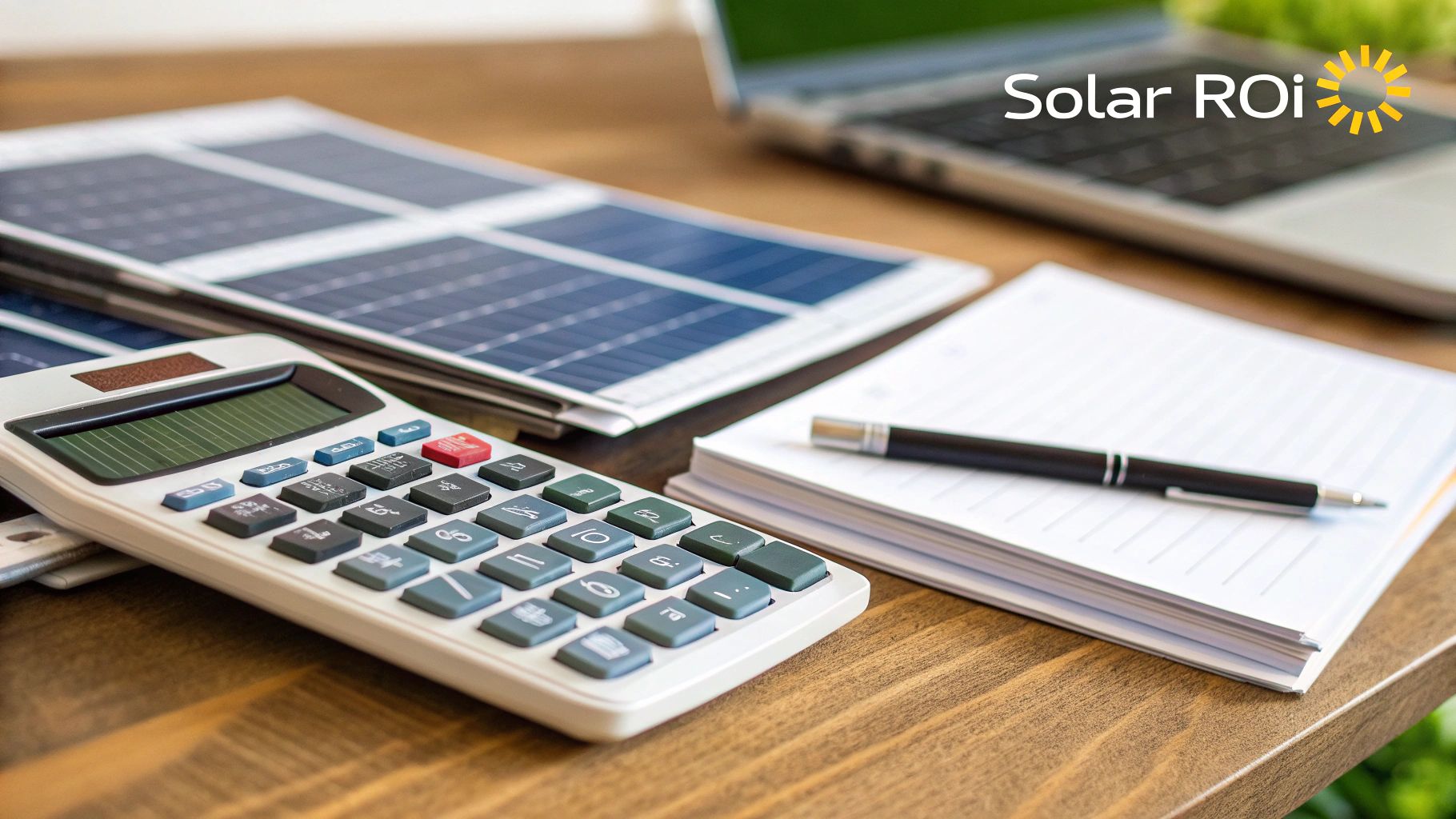
Simply put, the payback period is the amount of time it takes for your energy savings to completely cover the initial cost of the solar installation. Think of it as the breakeven point on your journey to generating free electricity.
The Simple Payback Formula
At its heart, the math is pretty straightforward. You can get a great ballpark estimate by using a simple formula that pits your net cost against what you’ll save each year. It gives you a clear timeline for when the investment has officially paid for itself.
Here’s the basic formula:
(Total System Cost – Incentives) / Annual Savings = Payback Period in Years
Let's unpack each part of that equation with a real-world example. It'll give you the confidence to run some initial numbers on your own.
A Practical Example for a Family Home
Let's imagine a typical family decides to install a solar system with a total cost of $20,000. This is a realistic number, as the average cost for a residential setup usually falls somewhere between $10,290 and $20,580.
Now, let's factor in the incentives:
- Federal Solar Tax Credit: This is a big one. The credit is currently 30% of the system's cost, so that’s $20,000 x 0.30 = $6,000 right back in their pocket.
- Net System Cost: After the tax credit, their actual out-of-pocket cost drops to $20,000 – $6,000 = $14,000.
Next up are the annual savings. Let’s say this family’s average electric bill was $150 per month, which adds up to $1,800 a year. A well-designed solar system could wipe out nearly all of that recurring expense.
Plugging these numbers into our formula:
$14,000 (Net Cost) / $1,800 (Annual Savings) = 7.78 years
In this scenario, the family's solar panels would pay for themselves in just under eight years. After that, every bit of energy their roof produces is pure savings—or profit—for the next 20+ years of the system's life.
It's always interesting to see how this payback compares to other green investments, which you can explore in a comprehensive electric vehicle cost comparison. And for a calculation tailored to your specific situation, feel free to plug your own numbers into our solar return on investment calculator.
How Real Homeowners Are Saving with Solar
All the formulas and calculators in the world can't tell the story of solar savings quite like the people who are actually living it. To truly understand how much you can save with solar panels, it helps to see how the investment is paying off for families across the country.
Let's look at three different households. Each one shows how local climate, utility rates, and personal goals come together to create a unique financial picture. While their numbers vary, they all arrive at the same conclusion: solar gives you control over your energy costs.
California Dreamin’: The Best-Case Scenario
First up are the Chens, living in sunny San Diego, California. If there was ever a perfect storm for solar savings, they were in it. California is known for its endless sunshine, but it's also infamous for having some of the highest electricity costs in the nation. Their bills were routinely hitting $300 a month, especially when the summer heat kicked in.
They went all-in with an 8kW system, big enough to cover more than 100% of their annual energy use. A hefty federal tax credit and a state rebate took a huge chunk out of the initial cost, making the numbers work.
The result? Their monthly power bill is now practically zero. On most days, their panels are spinning their meter backward, banking credits with the utility for any power they might need at night. For the Chens, this was about more than just erasing a bill; it was about breaking free from the grip of a volatile energy market.
The Northeast Success Story: High Rates Beat Less Sun
Now, let's travel across the country to Massachusetts and meet the Garcia family. They were understandably hesitant about solar. After all, New England isn't exactly famous for its year-round sunshine.
But what they lacked in sunny days, their utility company more than made up for with sky-high electricity rates. Their bills were averaging $220 per month. Even though their 7kW system doesn't produce as much power in a cloudy December as it does in July, every single kilowatt-hour it does generate is incredibly valuable. The savings they rack up during the long summer days are more than enough to carry them through the winter.
This is a perfect example of a crucial solar lesson: high electricity prices are just as important as the number of sunny days. The real value comes from the expensive grid power you don't have to buy.
The Garcias' story proves that your local utility rates are a massive part of the solar savings equation, sometimes even more so than the weather.
The Slow and Steady Win: Lower Costs, Long-Term Gain
Finally, let's check in with Mark, a homeowner in a Southeastern state where electricity is relatively cheap. His monthly bills were a manageable $110, so he wasn’t motivated by the immediate "bill shock" that drives many people to solar. Instead, he was playing the long game.
Mark opted for a smaller, more affordable 5kW system. Because his savings each month are more modest, his payback period is naturally longer than our other two families. But that wasn't the point. Mark has now locked in his electricity costs for the next 25+ years, making him completely immune to the unpredictable rate hikes his neighbors will face down the road.
Case Study Comparison of Solar Savings Scenarios
To put it all together, this chart compares these three different U.S. homeowners to show how location, system cost, and local energy rates influence the payback period.
gantt
title Solar Payback Period Comparison
dateFormat YYYY
axisFormat %Y
section Chens (CA)
Payback :crit, 2024-01-01, 5.6y
section Garcias (MA)
Payback : 2024-01-01, 7.3y
section Mark (GA)
Payback : 2024-01-01, 9.9y
As you can see, the path to breaking even and reaping the rewards of solar looks different for everyone. But whether the payback is fast or steady, these real-world examples make it clear that solar panels deliver powerful, lasting financial benefits.
Getting the Most Bang for Your Buck: How to Maximize Solar Savings
Putting solar panels on your roof is a fantastic start, but the real magic happens when you actively manage your system to squeeze every last drop of value out of it. Don't just think of it as an appliance; treat it like a long-term financial asset that you can fine-tune for the best possible return.
Your journey to maximum savings actually begins before a single panel is installed. Start with a home energy audit. Seriously. Finding and sealing air leaks, swapping out old appliances for energy-efficient models, or beefing up your insulation can slash your electricity usage. This means you might get away with a smaller, cheaper solar system that still covers 100% of your needs.
Nailing the Financials
How you pay for your system will have a massive impact on your total savings down the road. Paying in cash is the most straightforward way to get the highest ROI since you're not paying any interest. Of course, that’s a big chunk of change upfront.
Solar loans are a popular alternative, making the whole thing more accessible with little to no down payment. You'll have interest costs that eat into your savings a bit, but a huge part of maximizing your return is smart financing. For example, knowing the ins and outs of securing optimal equipment loan rates can dramatically lower your monthly payments and shorten your payback period.
Then you have leases or Power Purchase Agreements (PPAs). These get you immediate savings with zero upfront cost, which is great, but you won't own the system, and the long-term financial upside is much smaller.
One thing is absolutely non-negotiable: you must understand your utility's net metering policy. This is the rulebook for how you get credited for the extra power your panels push back to the grid, and it directly controls how much you can save.
A Simple Checklist for Keeping Your System in Top Shape
To keep your solar array humming along and producing at its best for years to come, just follow these simple rules:
- Don't Skimp on Equipment: Go for high-quality panels and inverters from reputable brands with solid warranties. They might cost a little more at the start, but their better performance and reliability will pay you back many times over.
- Keep an Eye on Production: Get familiar with your system's monitoring app. If you see a sudden dip in energy output, it's an early warning that something might need a look, protecting your investment from bigger problems.
- Clean Panels are Happy Panels: Keep your panels clear of dirt, leaves, or bird droppings. Just as important, trim back any tree branches that might start casting shadows on your roof—shading is a real energy killer.
- Time Your Energy Use: This is a simple but powerful habit. Try to run your big energy hogs like the dishwasher, laundry machine, or EV charger in the middle of the day when the sun is shining. That way, you’re using your own free power instead of buying it from the utility.
More Than Just Savings: The Hidden Perks of Going Solar
When people ask, "how much can you save with solar panels?" they're usually thinking about their monthly electricity bill. And while the savings there are fantastic, the real value of a solar investment runs much deeper. Think of it as a series of positive ripple effects that boost your home's marketability and contribute to a healthier planet.
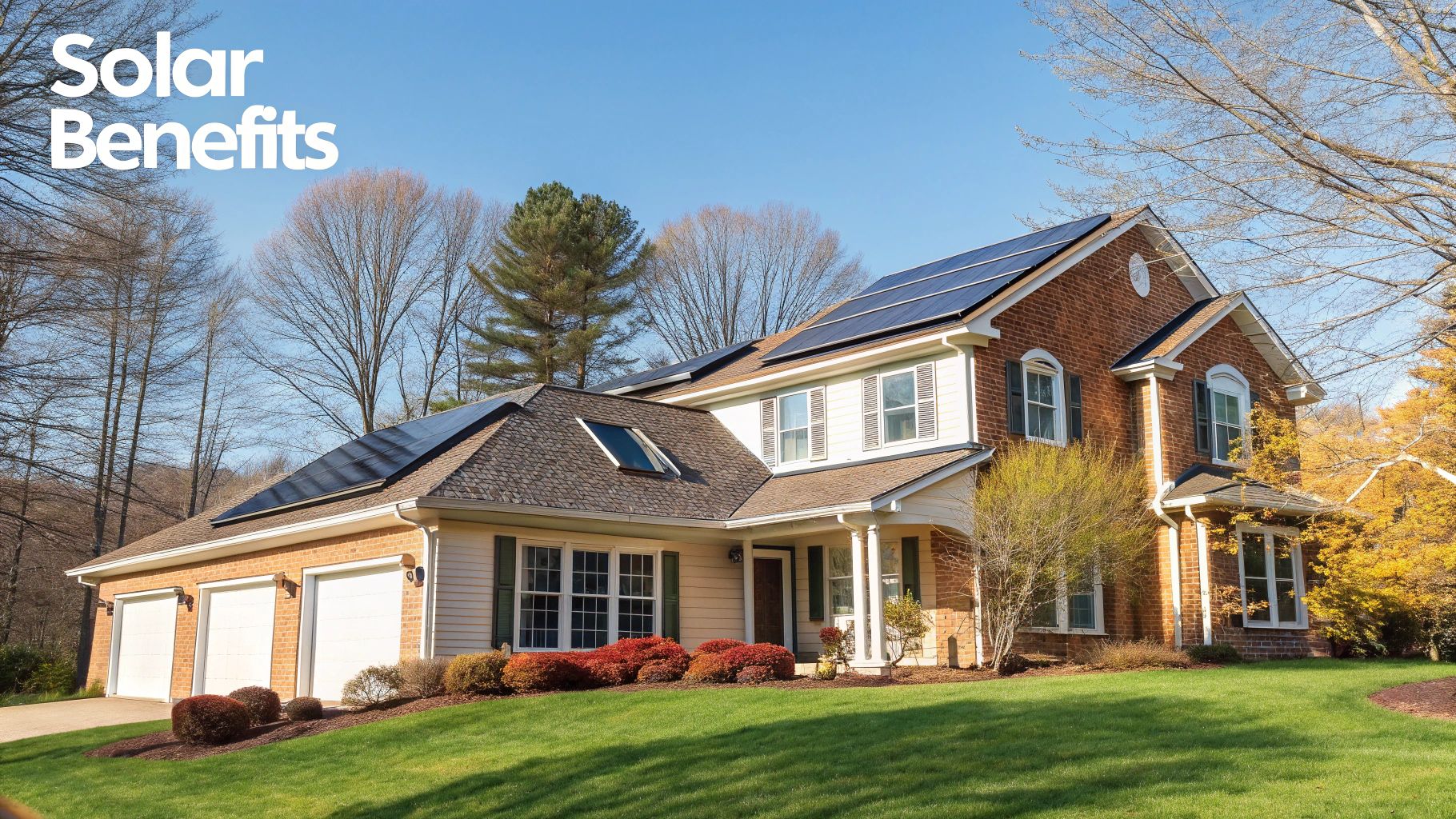
One of the biggest, and often surprising, benefits is the instant bump in your property value. In a competitive real estate market, a home with a solar installation is a premium asset. It just stands out, and research shows these homes often sell faster and for a higher price than their non-solar neighbors.
A Greener Footprint and a More Resilient Home
Beyond the purely financial upside, your solar system is a powerful statement about your commitment to the environment. When you generate your own clean electricity, you're taking a direct, measurable step to shrink your family's carbon footprint.
A typical residential solar setup prevents 3 to 4 tons of CO2 from being pumped into the atmosphere every single year. That's a serious contribution to a cleaner energy future. You can find more solar energy statistics and trends at enkonnsolar.com.
Your solar panels do more than save you money; they represent a tangible commitment to energy independence and environmental responsibility. This investment pays dividends to both your wallet and the world around you.
This commitment also makes your home stronger. When the grid goes down, most people are left in the dark. But with solar, especially when you add a battery, you have a reliable power source to keep your family safe and comfortable through an outage.
- Property Value: On average, homes with solar panels see their resale value increase by 4.1%.
- Energy Security: Your system gives you a shield against unpredictable utility rate hikes and blackouts. Check out our guide on battery backup systems for homes to see how you can achieve true energy independence.
- Environmental Impact: Over its 25-year lifespan, a standard home solar system provides an environmental benefit that’s like planting thousands of trees.
Still Have a Few Questions? We’ve Got Answers
After running through all the numbers and benefits, you're probably still kicking a few specific questions around in your head. That's completely normal. Let's tackle some of the most common ones we hear from homeowners, so you can feel totally confident about what to expect.
Do Solar Panels Still Work When It's Cloudy?
You bet they do. While a bright, sunny day is when your panels will be at their most productive, they are surprisingly good at generating power from indirect sunlight.
Think of it this way: you can still get a sunburn on a cloudy day, right? That's because UV rays are still getting through. Your solar panels work on a similar principle, capturing that diffused light and turning it into electricity. On a really overcast day, you might see production drop to 10-25% of the system's peak output, but it's far from zero—it's still chipping away at your energy costs.
Will My Electric Bill Actually Be $0?
It’s possible to hit that magic "net-zero" number, but it's not always the reality or even the main goal. To completely wipe out your bill, your system would need to produce more power over the year than your home consumes.
What's more common is that you'll still get a small monthly statement from your utility company. This usually covers fixed charges like grid connection fees or local taxes that everyone has to pay, regardless of how much power they use. The real win is slashing the variable part of your bill—the part based on your electricity usage—down to $0.
Think of it like this: even if you have a small, fixed charge from the utility, you’ve essentially eliminated the unpredictable, usage-based cost of electricity. You're locking in your energy price for the next 25+ years. That’s where the real savings power lies.
What Happens If the Power Goes Out?
This is a really important one to understand. For safety reasons, a standard solar panel system that's tied to the grid is designed to automatically shut down during a power outage. This prevents your panels from sending electricity back into the grid while utility crews are working on the lines.
If you want true energy independence and need power during an outage, you’ll want to pair your solar panels with a home battery. A battery stores the extra solar power you generate during the day, creating your own personal backup supply that can keep the lights on when the grid goes dark.
Ready to stop wondering and get a real answer for your home? The team at Radiant Energy can run the numbers and give you a clear, personalized quote with no strings attached. Get your custom solar savings estimate today!


